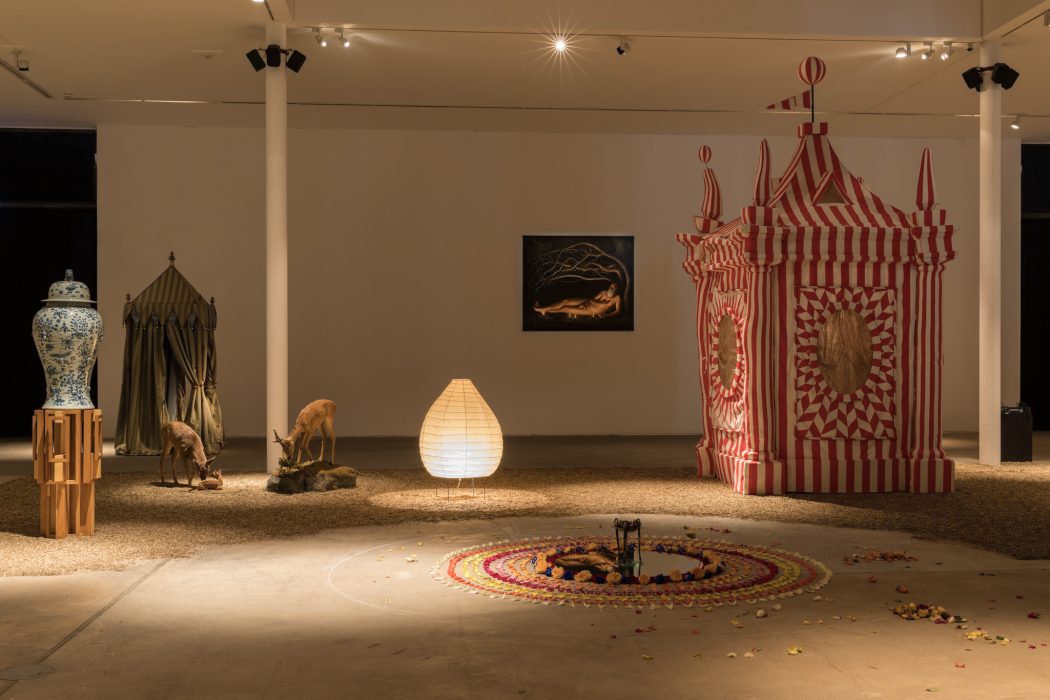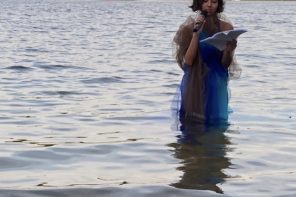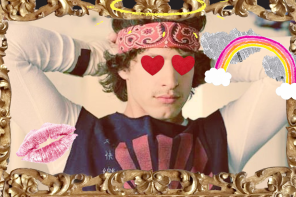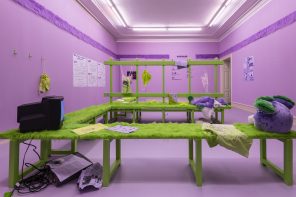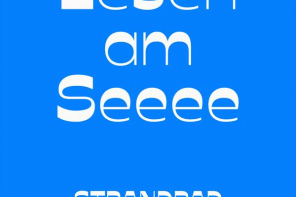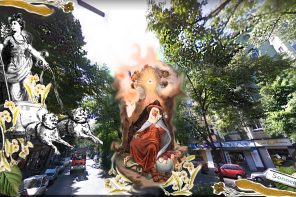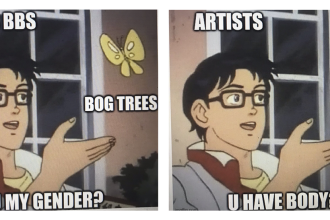In the last weekend of April, KW Institute Berlin hosted a meditative and immersive installation/constellation from AA Bronson and his circle of collaborators. Including performances and artworks from Bronson and other artists, the five day hybrid exhibition marked the pre-opening of Gallery Weekend Berlin. Unlike the majority of the other exhibitions, however, Bronson’s Garten der Lüste distinguishes itself by insisting on the understanding of art as a collective, curative, and meditative process.
The exhibition’s meticulous lighting design pulls the viewer to the gravitational center of the exhibition on the lower level. In a large space, several tents surrounded by various objects and artworks, as well as an elaborate flower mandala, appear to be points for retrospection and meditation. Folly (2015), comprised of a carnival tent and several objects on top of a mugwort bed, is accompanied by Ebe Oke’s ambient sound work FIELD (2015), and Oke’s vocal performance, which occurs at certain intervals. In another piece, Tent for Healing (2013), AA Bronson converses with the guests as a healer. This work is the embodiment of the exhibition’s curative element. The visitors who would like to enter the Tent for Healing need an appointment and are requested to offer the healer a gift that is of utmost value to them – a process I did not have the chance to experience.
The idea of the artist as a healer is not new, but combined with the meditative and collective spirit of the exhibition, it acquires a refreshing modality that transforms the ways we look at, and engage with art. Cabine (2008), a tent reminiscent of both a fortuneteller’s booth and a cabin in a gay sauna, offers the meditative performance Fish Scroll (Yaldaboath) by artist Michael Dudeck. Dudeck’s body is elaborately painted. He sits on the floor with a dead fish in his arms and chants words, or maybe even sentences, from an invented language. At the time of my visit on opening night, I was enchanted by the ways in which Dudeck’s chanting and later Oke’s vocals transfixed our attention for extended periods of time. Looking at all of this from above, the image of AA Bronson, in a painting titled AA in the Magic Forest (2015) by TM Davy, frames the whole exhibition with a sense of familiarity. In some ways, I imagine, Bronson exercises a kind of magic in this exhibition by the form of its design. In this specific sense, and at a time when the focus on individual innovation mirrors neoliberal conceptions of a solipsistic subjectivity and a fragmented society, Bronson’s Garten, a collaborative and curative constellation, revitalizes the ways in which art connects to the audience.
The transformation of how the viewer sees the artwork is also central to AA Bronson’s other Berlin exhibition Catch me if you can! by AA Bronson + General Idea at Esther Schipper, but with a caveat. As the only surviving member of the group General Idea, Bronson continues the dialogue that he started in collaboration with Felix Partz and Jorge Zontal in 1968. The gallery space is devoted to a retrospection of General Idea’s works across several decades, as well as Bronson’s continuation of this process.
Although the space and the design of the exhibition lacks, to a certain extent, the vigor that Garten has, it is nonetheless a historically contingent collection of works that appear to my eyes both as a practice of curating memories and memorializing the past and present. Several mirror self-portraits of General Idea from the 1970s replicate this central idea while historically significant pieces such as Bubble Machine #2 (2003) challenges the voyeur by invoking a contradiction between several small mirrors and the geodesic dome, which replicates the visual anatomy of the human immunodeficiency virus. El Dorada Series (1992) brings together different elements and appears as a crucial part of the exhibition’s narrative. The series is composed of several abstract paintings, evoking the caste paintings commissioned by Philip V of Spain in 18th century in order to catalogue Latin and South American ethnic groups. The abstract paintings appear as extreme close-ups of different skin tones, which once again emerge as a clear statement against certain dominant ways of seeing the world and others.
I attended the show with probably more than a couple hundred people, which led to my confusion regarding how the viewer perceives the exhibition. Catch me if you can!, as part of a large-scale and hyper-professionalized event such as Gallery Weekend, attracted such a crowd who, as I saw from the corner of my eye, walked or perhaps ‘strolled’ by the artworks, spending less than 5 seconds on each piece. This particularly noteworthy issue is unfortunately also evident in some of the reviews of the exhibition.
The case in point is AA Bronson’s portrait, Flasher, in collaboration with Matthias Herrmann (2018), in which Bronson poses naked to the viewer and quite straightforwardly states a liberating detachment from the hegemonic public gaze. In that regard, the statement of a reviewer, I quote, “a portrait of a man leaving little to the imagination”, replicates the continuous flow of people who pass by the art, adding a certain level of provocation without engaging with the work itself. The failure of the reviewer to identify AA Bronson mirrors this ‘browsing’ of exhibitions in a manner that is perhaps best visualized in the image of the consumer in a shopping mall.
The irony, however, is that the image of a strolling consumer does not necessarily correspond to the image of real buyers and collectors, who, as I heard from a gallery worker, visited the galleries earlier in the morning, arriving in their limousines. In a way, however, I find it curious that the larger, and financially impactful, commercial engagement with art re-emerges even in the behaviour of the strolling viewers, sans the buying. This situational contradiction, of course, is not a comment on the work of AA Bronson and General Idea. On the contrary, the very nature of the exhibition continues to alter the visual discourse of public gaze and individual opinion as it refrains from imposing a specific opinion of itself, thereby leaving the ground open to the passerby as an ultimately social process. The issue of presenting art in radically challenging and engaging ways, however, is in desperate need of attention.
Author: Emre Yeşilbaş
Header Image: AA Bronson, Garten der Lüste, 2018, installation view at KW Institute for Contemporary Art, photo: Frank Sperling
Emre Yeşilbaş is a writer, researcher and teacher based in Berlin.

